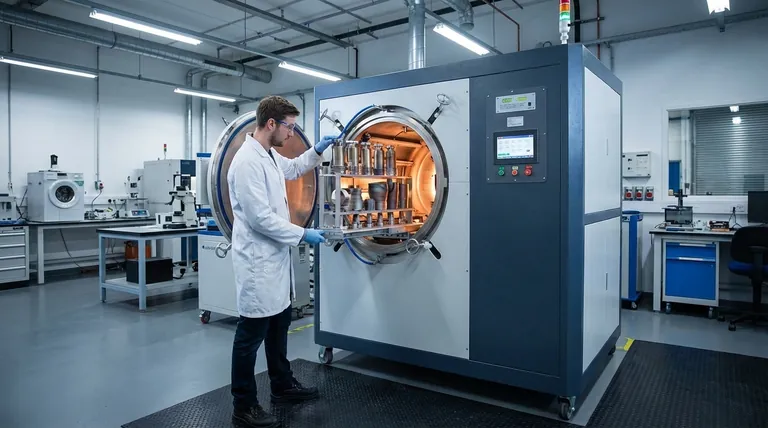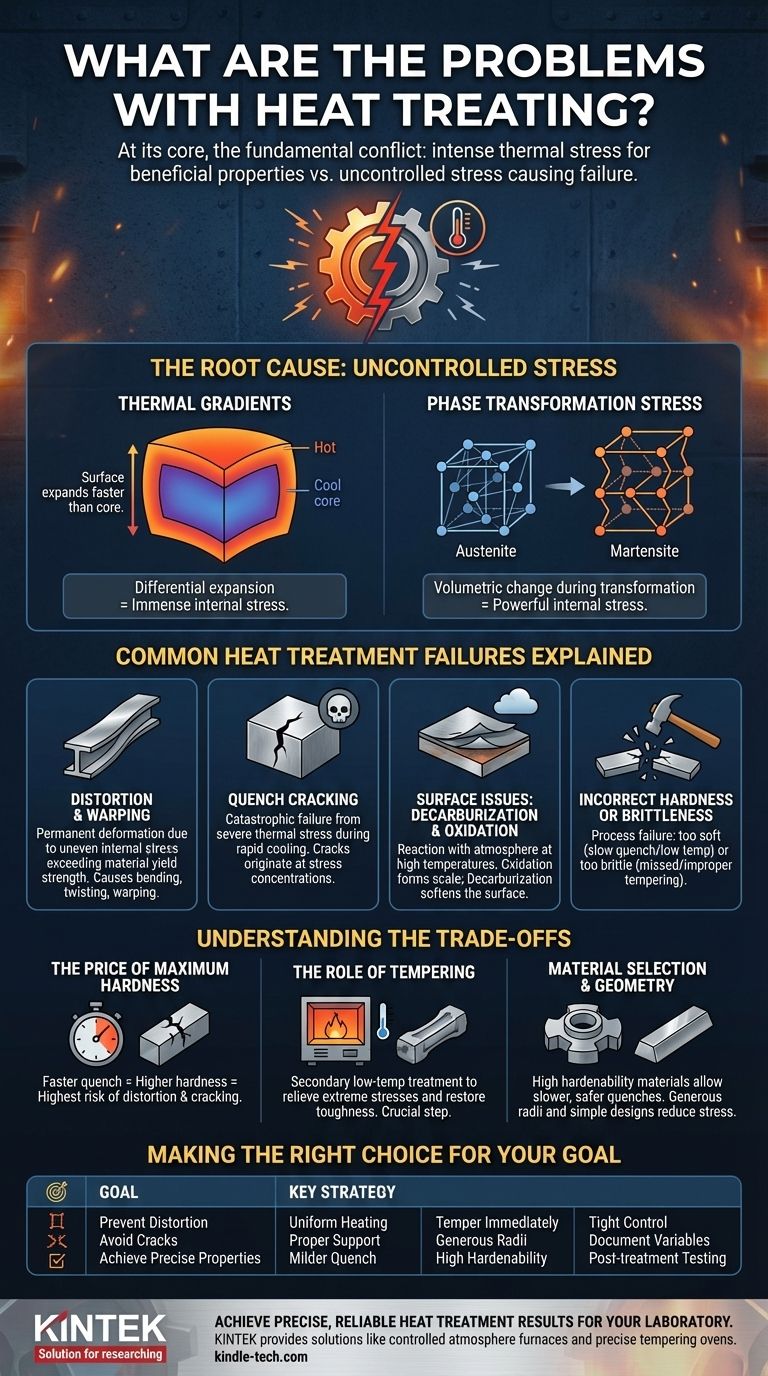At its core, the problems with heat treating arise from a fundamental conflict: the process uses intense thermal stress to create beneficial material properties, but if that stress is uncontrolled, it becomes the direct cause of failure. The most common problems include distortion, cracking, undesirable surface changes like decarburization, and failing to meet the target hardness or strength.
Heat treatment is not merely about heating and cooling metal; it is the precise management of internal stresses. Every major problem, from a warped part to a catastrophic crack, is a symptom of these stresses being applied unevenly or in excess of what the material can withstand.

The Root Cause: Uncontrolled Stress
Nearly every issue in heat treating can be traced back to two types of internal stress that are intentionally induced but must be carefully managed: thermal stress and transformation stress.
Thermal Gradients
Heating and cooling cause metal to expand and contract. When a part is heated or cooled too quickly, the surface changes temperature far faster than the core.
This difference, known as a thermal gradient, causes the surface and the core to expand or contract at different rates. This differential movement creates immense internal stress.
Phase Transformation Stress
The entire purpose of many heat treatments is to change the material's internal crystal structure, or phase. For steel, this often means transforming a structure like austenite into a much harder structure like martensite.
This transformation is not just a structural change; it's a volumetric one. Martensite, for instance, takes up more volume than the austenite it forms from. When this transformation happens at different times across the part, it creates another layer of powerful internal stress.
Common Heat Treatment Failures Explained
When the combination of thermal and transformation stress exceeds the material's strength at a given temperature, failure occurs.
Distortion and Warping
Distortion is the most common problem. It is the permanent plastic deformation of a part caused by the yielding of the material under internal stress.
Parts with thin sections, sharp corners, or significant changes in cross-section are highly susceptible. The stress concentrates in these areas, causing them to bend, twist, or warp as the material relieves that stress.
Quench Cracking
This is the most catastrophic failure. A quench crack occurs when the internal stress generated during rapid cooling (quenching) exceeds the ultimate tensile strength of the newly formed, brittle microstructure.
These cracks often originate at areas of high stress concentration, such as keyways, holes, or sharp internal corners. They are typically a result of a quench that was too severe for the material or the part's geometry.
Surface Issues: Decarburization and Oxidation
At high temperatures, the surface of the steel can react with the atmosphere in the furnace.
Oxidation, or scale, is the formation of iron oxides on the surface. Decarburization is the loss of carbon from the surface of the steel, which results in a soft, weak outer layer that will not achieve the desired hardness. Both are controlled by using a vacuum or a controlled, non-reactive atmosphere.
Incorrect Hardness or Brittleness
Achieving the wrong final properties is a process failure. If the hardness is too low, the part likely wasn't heated to the correct temperature or cooled quickly enough to form the target microstructure.
If the hardness is correct but the part is excessively brittle, it is often because of a missed or improperly performed tempering operation. A part in its fully hardened, as-quenched state is too brittle for most applications.
Understanding the Trade-offs
Successful heat treatment is a series of calculated compromises. The key is understanding the relationship between process variables and risk.
The Price of Maximum Hardness
To achieve the highest possible hardness in many steels, you need a very fast quench to ensure a fully martensitic transformation. However, a fast quench also creates the most severe thermal gradients.
This means that the pursuit of maximum hardness inherently carries the highest risk of distortion and cracking.
The Role of Tempering
Tempering is a secondary, low-temperature heat treatment performed immediately after quenching. Its purpose is to relieve the extreme internal stresses from the quench and restore a degree of ductility and toughness.
The trade-off is a slight reduction in hardness and strength. Skipping or delaying this step on a hardened part is a common and costly mistake, as the part remains in its most stressed and brittle state.
Material Selection and Geometry
Not all materials or designs are created equal. A complex part with many sharp corners made from a low-hardenability steel (which requires a very fast quench) is a recipe for failure.
Choosing a material with higher hardenability (like an alloy steel) allows for a slower, less severe quench to achieve the same hardness, dramatically reducing the risk of distortion and cracking. This is often the most effective way to mitigate risk.
Making the Right Choice for Your Goal
Controlling the problems of heat treating requires aligning your process with your primary objective.
- If your primary focus is preventing distortion: Prioritize uniform heating, proper furnace loading to support the part, and selecting the mildest quench possible that still meets your property requirements.
- If your primary focus is avoiding cracks: Always temper the part immediately after quenching, use generous radii on all corners in your design, and select a material with sufficient hardenability to allow for a slower quench.
- If your primary focus is achieving precise mechanical properties: Insist on tight control and documentation of all process variables—temperature, soak time, atmosphere, and cooling rates—and mandate post-treatment verification testing.
Ultimately, successful heat treatment is achieved by mastering the control of internal stress, not just by applying heat.
Summary Table:
| Problem | Root Cause | Key Prevention Strategy |
|---|---|---|
| Distortion/Warping | Uneven thermal stress causing plastic deformation | Use uniform heating, proper part support, and a milder quench |
| Quench Cracking | Internal stress exceeding the material's tensile strength | Use generous radii in design, proper tempering, and select suitable material |
| Surface Decarburization | Reaction with furnace atmosphere at high temperatures | Use a controlled or vacuum atmosphere during heating |
| Incorrect Hardness/Brittleness | Improper temperature, cooling rate, or missed tempering step | Ensure precise process control and perform mandatory post-quench tempering |
Achieve precise, reliable heat treatment results for your laboratory. The challenges of distortion, cracking, and inconsistent properties can be mitigated with the right equipment and expertise. KINTEK specializes in lab equipment and consumables, providing solutions like controlled atmosphere furnaces and precise tempering ovens that help you master internal stress. Let our experts help you select the right tools to ensure your heat treatment processes are a success. Contact us today to discuss your specific laboratory needs!
Visual Guide

Related Products
- Vacuum Heat Treat Furnace with Ceramic Fiber Liner
- Molybdenum Vacuum Heat Treat Furnace
- Vacuum Heat Treat Furnace and Levitation Induction Melting Furnace
- 2200 ℃ Graphite Vacuum Heat Treat Furnace
- 2200 ℃ Tungsten Vacuum Heat Treat and Sintering Furnace
People Also Ask
- What are the advantages of a vacuum furnace? Achieve Superior Purity and Control in Heat Treatment
- What materials are used in a vacuum furnace? Selecting the Right Hot Zone for Your Process
- What is the leak rate for a vacuum furnace? Ensure Process Purity and Repeatability
- What materials are used in a vacuum furnace? A Guide to Hot Zone Materials and Processed Metals
- How to vacuum out a furnace? A Step-by-Step Guide to Safe DIY Maintenance



















